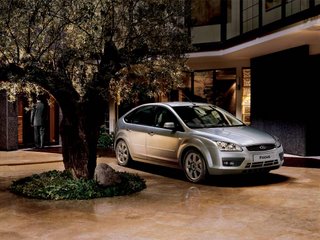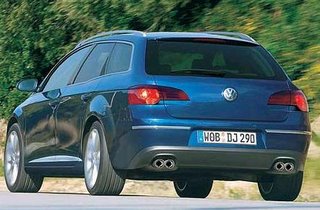This is a wrap-up of previous blog entries regarding the Ford Focus. The Focus II is (IMO) a rather dull car. Why is something with such a boring design referred as “the new compact”? Honestly, I find it difficult to explain. But fact is, the Focus II is the most important representative of the most recent trends in the compact segment. Because of several of its features but mainly because it is the best-selling compact in Europe since the beginning of this year (actually since the final months of 2005). And this is a major point. For many many years the VW Golf was the best selling compact in Europe. This helped establish the Golf as the reference model, the default choice in this segment, a benchmark. If not for its attributes, the single fact that it was the best selling compact made it the first choice for many people. And was enough to make this class of cars be referred by many as “the Golf segment”.Not anymore. The Focus is now the best-selling compact in Europe. It is the new benchmark, the reference of the compact class. The new king. The new compact. And the commercial performance of the Focus is even more impressive because for once it has a very boring design (and we Europeans are supposed to not like boring designs) and also because Ford is an American brand. Well, in reality Ford Europe is completely different from Ford America or Ford down-under. But still, it’s an American brand. This means that the Focus can never make it to top spot of sales in Germany or France, the biggest European markets. In Germany the Golf will always be the leader, and in France it will always be a Renault or Peugeot in the top of sales charts. Thus the Focus must perform really well in the rest of the European markets. And it must have a very impressive set of features to overcome its design. It’s really hard to explain how such a dull design can do so well in Europe…Auto-Future looks closely at the new compact. The most important trends and features in this class and why the Focus II is the new reference, the new leader, the new benchmark, the new compact.
.

The new compact is big
For a 4342mm length the Focus II has a massive 2640mm wheelbase (only 8mm shorter than a Audi A4) and a huge 1840mm width. This means loads of space both for occupants and luggage. So big is the new compact that one does not have much advantage in space in a Mondeo over a Focus SW or a Focus C-máx. This is in itself a recent trend that has helped conventional 4-door sedans to loose a lot of sales for these models. Incidentally, the compact segment also lost appeal for consumers that don’t need much space: today, cars like the Peugeot 207 or Fiat Grande-Punto can fill the space needs for many consumers as these are about the same size as a Golf III.
The massive size of modern “compacts” is in the origin of another trend: future versions of these cars will not grow much more in size. And will not change a lot in their underpinnings. So expect mainly design and interior improvements for the Focus III and Golf VI. On the other hand, the current Opel Astra will have to be greatly improved for the next generation, not only in size and space but mainly in suspension design… But the current Astra is what might be called in this context “old compact”.

The new compact is sophisticated
Both in electronics and equipments but mainly in chassis and suspension design. The new compact (as pioneered by the Focus I but followed by the VW Golf V) has very sophisticated multilink rear suspension design. But also very high body stiffness. The most advanced representatives of this class (Focus II and Golf V) are in reality smaller versions of their bigger brothers (next Mondeo and current Passat) sharing most of the suspension parts and underpinnings. This level of engineering means that the new compact drives exceptionally well combining great levels of comfort, handling and safety. In this particular the Focus II is clearly superior to the VW Golf, mainly due to its bigger footprint (wheelbase x width) and Ford’s extensive experience with multilink suspension design. It is really impressive how the Focus can still be very comfortable with 17’’ wheels while displaying amazing handling, safety and agility.This level of sophistication will be followed by other competitors, although it is not clear if the French machinery will upgrade to multilink suspensions: current versions of the Peugeot 307 and Renault Mégane are still very competitive in handling and comfort even if using old suspension design… On the other hand the current Opel Astra will have to upgrade a lot. Actually, if the Opel Signum could be made a bit smaller (and cheaper) maybe then it could compete with the Focus II…

The new compact is mainstream
Although big and sophisticated the new compact is good value. And the leaders in this segment have realized that it is not worth trying to sell these cars as premium. For that purpose there is the Volvo S40 and C30 (in the Focus family) and the Audi A3 (in the Golf family). And of course the more informed and cash-filled buyers will wisely spend their money in the BMW 1-series and Mercedes sportcoupe that really have a superior RWD architecture. In this particular the Focus II excels since it has very competitive pricing. But the Golf V rapidly lowered the usual VW prices and now fights head to head with the rest of the mainstream players. The “back to mainstream” route will be further accelerated with the next Golf VI.
However, this move to maistream does not mean that manufacturers won't try to be more profitable in this segment. The future trend is to keep basic hatchback versions very competitive in price and use the niche versions (CC, small SUV, sporty coupé) to move up in the price scale.

The future of the new compact
One blog entry is missing here: the one entitled “the new compact is dull”. Fortunately the future of this class of cars will see more emotional designs. Next generation of the Ford Focus will follow the “kinetic” theme established by the new Ford S-máx. The CGI presented below (by Schulte) is obviously based on the Iosis concept (as every future Ford CGI these days). Even if it will not look like that it will have much more emotional appeal than the current vehicle. Let’s face it the current (European) version is so dull that it can only improve!Same thing for the Golf. The next iteration will have a much fresher look. The current Golf V is also a bit boring which explains part of its failure. However, although loosing the top spot in sales, one should not think of the Golf as the looser in this context. If you read carefully what was written in this blog about the new compact you will see that the Golf is as trend setting as the Focus. And in the future it will have very good chances of fighting the Focus, mainly in the more profitable niche versions. The next Golf SUV and Focus-derived CUV will be leveled, but the VW Eos will have much more success than the Focus CC (what an ugly thing!) and the Golf coupe version (Scirocco) will be a future icon while for now no Focus equivalent is expected.




















